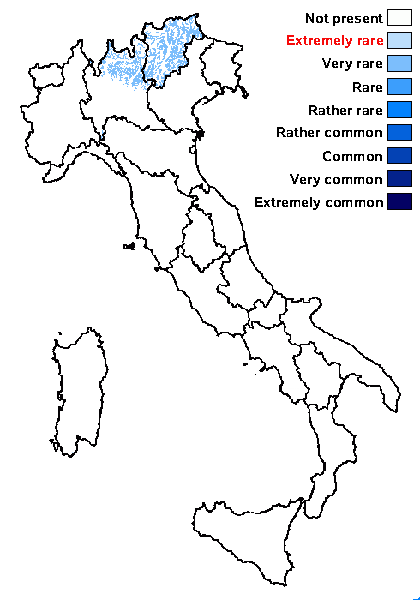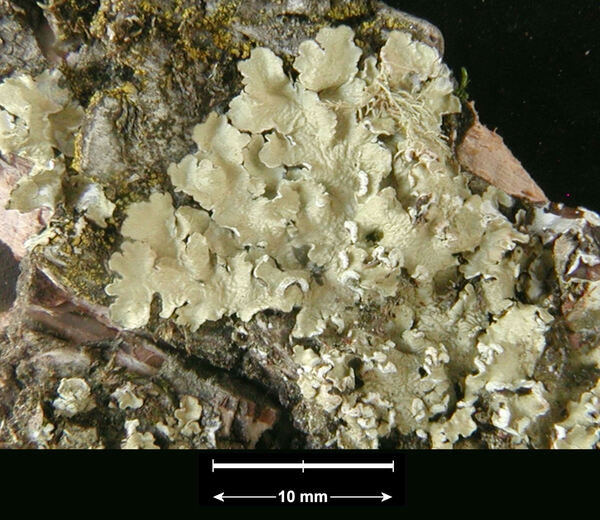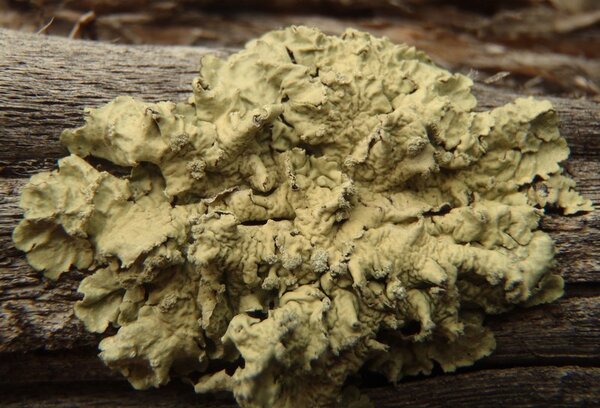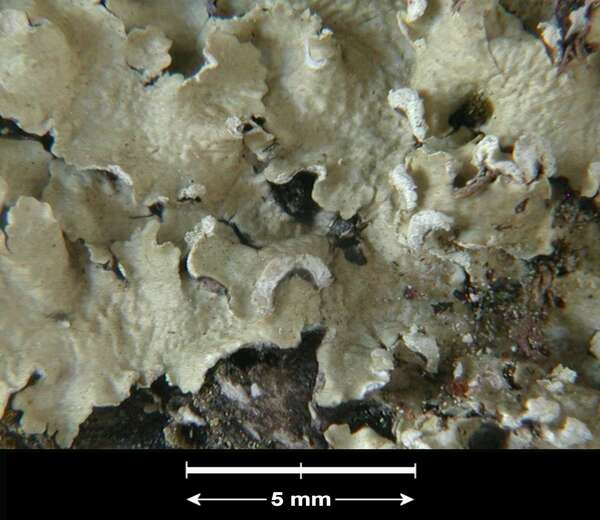Flavopunctelia soredica (Nyl.) Hale
Mycotaxon, 20: 682, 1984. Basionym: Parmelia soredica Nyl. - Flora, 68: 605, 1885.
Synonyms: Parmelia manshurica Asahina; Parmelia ulophyllodes (Vain.) Savicz; Punctelia soredica (Nyl.) Krog
Distribution: N - TAA (Nascimbene 2005b, 2006c, 2014, Nascimbene & al. 2007b, 2014), Lomb.
Description: Thallus foliose, heteromerous, dorsiventral, appressed to tightly adnate, forming up to 10(-12) cm wide rosettes. Lobes contiguous, flat, 3-8 mm wide, with rounded apices. Upper surface yellowish green, turning brownish in the herbarium, smooth to weakly wrinkled, frequently maculate but rarely with true, very small, punctiform pseudocyphellae. Soredia white, farinose to granular, arranged into crescent- to lip-shaped soralia along the reflexed, wavy lobe margins, rarely laminal. Lower surface smooth to finely wrinkled, dark brown at margin, black in central parts, with simple or rarely forked, short, dark rhizines which usually lack in a narrow marginal zone. Upper cortex paraplectenchymatous, with a non-pored epicortex, the cell walls with an intermediate type of lichenan; medulla white; algal layer continuous; lower cortex paraplectenchymatous. Apothecia rare, lecanorine, with a brown disc and an often sorediate thalline margin. Epithecium brownish; hymenium and hypothecium colourless. Asci 8-spored, clavate, Lecanora- type. Ascospores 1-celled, hyaline, ellipsoid, 9-12 x 5-7 µm. Pycnidia rare, black. Conidia straight, bifusiform, 7-11 µm long. Photobiont chlorococcoid. Spot tests: upper cortex K+ yellowish, KC-, C-, P-; medulla K-, C+ red, KC+ red, P-. Chemistry: upper cortex with usnic acid; medulla with lecanoric acid (major) and 5-chlorolecanoric acid (minor or trace).Note: a mainly epiphytic species, restricted to Alpine valleys with a continental climate, certainly very rare in Italy. It is included in the Italian red list of epiphytic lichens as “Endangered” (Nascimbene & al. 2013c).
Growth form: Foliose, broad lobed
Substrata: bark
Photobiont: green algae other than Trentepohlia
Reproductive strategy: mainly asexual, by soredia, or soredia-like structures (e.g. blastidia)
Subcontinental: restricted to areas with a dry-subcontinental climate (e.g. dry Alpine valleys, parts of Mediterranean Italy)
Commonnes-rarity: (info)
Alpine belt: absent
Subalpine belt: very rare
Oromediterranean belt: absent
Montane belt: very rare
Submediterranean belt: absent
Padanian area: absent
Humid submediterranean belt: absent
Humid mediterranean belt: absent
Dry mediterranean belt: absent

Predictive model
Herbarium samples
Growth form: Foliose, broad lobed
Substrata: bark
Photobiont: green algae other than Trentepohlia
Reproductive strategy: mainly asexual, by soredia, or soredia-like structures (e.g. blastidia)
Subcontinental: restricted to areas with a dry-subcontinental climate (e.g. dry Alpine valleys, parts of Mediterranean Italy)
Commonnes-rarity: (info)
Alpine belt: absent
Subalpine belt: very rare
Oromediterranean belt: absent
Montane belt: very rare
Submediterranean belt: absent
Padanian area: absent
Humid submediterranean belt: absent
Humid mediterranean belt: absent
Dry mediterranean belt: absent

Predictive model
| Herbarium samples |
 Index Fungorum
Index Fungorum
 GBIF
GBIF





